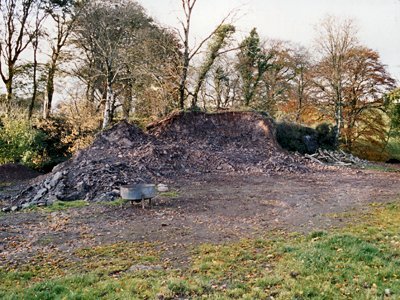Earth Science Conservation Review
| Knockaraven Townland quarry | Tyrone |
| Site Type: | Quarry (disused) |
| Site Status: | ESCR |
| Council area: | Omagh District Council |
| Grid Reference: | H33526452 |
| Google maps: | 54.52822,-7.48256 |
| Rocks | |
|---|---|
| Rock Age: | Devonian (Famennian, Frasnian) |
| Rock Name: | Fintona Group, Shanmullagh Formation (Form Blm) |
| Rock Type: | Breccia, Mudstone, Sand, Sandstone, Siltstone |
| Interest | |
| Fossil Groups: | Miospore, Miospores |
Description:
About 5m of highly sheared rock is exposed in the quarry face excavated into this rock knoll. The top 4m consists of inter- bedded purple-red and brown silty fine-grained calcareous sandstone and muddy siltstones in which bedding is difficult to distinguish. Beds of purple-red siltstone containing numerous clasts of green mudstone are very common. The lowest 1m in the pit consists exclusively of laminated dark and light green mudstones which are both continuous and disrupted to produce thin breccias.^2^
Two samples of green mudstone from the quarry were processed and yielded very sparse, poorly preserved miospores, including Apiculiretusispora sp., Bascaudaspora collicula (Playford) Higgs, Clayton & Keegan 1988, and Emphanisporites spp.
A much more abundant assemblage of well preserved miospores obtained from loose blocks of green mudstone, that had been extracted from the quarry and used as farmfill at a site (H34746002) 3km south of Dromore and 5.5km south-south-east of the quarry, included the following forms: Aurorospora spp., Bascaudaspora sp., Densosporites sp., Dictyotriletes sp., Emphanisporites sp., ? Hymenozonotriletes sp., and Samarisporites sp.
Two samples of green mudstone from the quarry were processed and yielded very sparse, poorly preserved miospores, including Apiculiretusispora sp., Bascaudaspora collicula (Playford) Higgs, Clayton & Keegan 1988, and Emphanisporites spp.
A much more abundant assemblage of well preserved miospores obtained from loose blocks of green mudstone, that had been extracted from the quarry and used as farmfill at a site (H34746002) 3km south of Dromore and 5.5km south-south-east of the quarry, included the following forms: Aurorospora spp., Bascaudaspora sp., Densosporites sp., Dictyotriletes sp., Emphanisporites sp., ? Hymenozonotriletes sp., and Samarisporites sp.
| Enlander, I., Dempster, M. & Doughty, P., 2025. Knockaraven Townland quarry, County Tyrone, site summary. [In] Earth Science Conservation Review. https://www.habitas.org.uk/escr/summary.php?item=319. Accessed on 2025-10-23 |
| Previous Site | Next Site |

